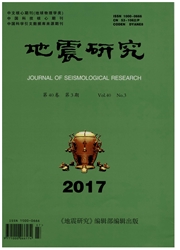

 中文摘要:
中文摘要:
通过野外活动断裂地质填图,获得了云南西南部黑河断裂的断错微地貌、断错地层、最新活动时代及滑动速率等定量参数。对比分析表明,黑河断裂具有较明显的分段活动特征,根据断层几何特征大致可划分3条次级断裂段,自西向东分别为沧源-木戛段、木戛-南代段和南代-勐往段,各段晚第四纪以来新活动形成了丰富的断错地貌现象。由断层剖面及断错地貌特征分析,黑河断裂全新世晚期具分段破裂特征,其中沧源-木戛段存在古地震形变带,其年代介于(242±44)aB.P.和(1714±49)aB.P.之间,木戛-南代段是1988年澜沧7.6级地震的主破裂带之一,南代-勐往段全新世晚期有过活动,最晚离逝时间介于(550±30)aB.P和(1290±30)aB.P.之间。根据对断错冲沟及台地的差分GPS测量和相应年代测试,得到沧源-木戛段全新世以来的右旋走滑速率为(4.0±0.7)mm/a,木戛~南代段全新世的右旋走滑速率为(3.5±0.8)mm/a。
 英文摘要:
英文摘要:
Through field geological investigation, we obtained the quantity factor of Heihe Fault in southwest Yunnan, such as the dislocation microrelief, displaced stratum, the newest active age and slip rate etc. It turns out that the Heihe fault zone has the obvious characteristics of the segmented activities by comparing and analyzing. Basing on the geometrical features of the Heihe Fault, we divided it into three secondary fault segments: Cangyuan-Muga, Muga-Nandai, Nandai-Mengwang, and a variety of dislocation landforms had been formed in the new fault activities of each segment since the late Quaternary. We analyzed the fault section and fault landform characteristic, and obtained that the Heihe Fault had the characteristic of segmentation rupture in late Holocene. The deformation zones of paleoseismic were discovered on the Cangyuan-Mujia segment. The carbon dates of faulted and un-faulted deposit showed that some earthquake had occurred between (242±44) a B. Po and (1 714±49) a B. P.. The Mujia-Nandai segment was one of the main rapture zones of Lancang Ms7.6 earthquake in 1988. The Nandai-Mengwang segment was active during the late Holocene, and its elapsed time was between (550±30) a B. P. and (1290±30) a B. P. at the latest. According to the differential GPS measurement and the corresponding sample dating of dislocation gully and terrace, we obtained that the right-lateral strike slip rate of Cangyuan-Mujia segment and Mujia-Nandai segment were (4.0±0. 7) mm/a and (3.5±0. 8) mm/a respectively during the late Holocene.
 同期刊论文项目
同期刊论文项目
 同项目期刊论文
同项目期刊论文
 期刊信息
期刊信息
